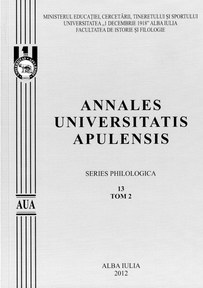Narativ şi non-narativ în proza lui Ştefan Aug. Doinaş
Narrative and non-narrative in the prose of Ştefan Aug. Doinaş
Author(s): Mihaela DoboşSubject(s): Literary Texts
Published by: Universitatea »1 Decembrie 1918« Alba Iulia
Keywords: literary essay; hybridization; inter-genre; non-narrative; prose; reflexivity
Summary/Abstract: The prose of Ştefan Aug. Doinaş originally completes the constellation of his literary creation, exceeding, in a final analysis, the stage of a simple experiment. In its substance, the anthology entitled T de la Tresor (T for Tresor) offers the reader a completely unprecedented perspective about the writer, by taking into consideration the different nature of the reality report peculiar to the period. In spite of stepping over the lyrical space, Doinaş remains faithful to poetry even on the territory of prose, by means of the subjective contemplation that prevails in many of his texts, the consistent openings towards the symbolic, allegorical, and the descriptive, or by means of the careful stylization of the discourse. The non-narrative is the generic term that expresses the symptoms of a relatively new opening manifested in prose. This category comprises, in general, short texts, which lack intrigue, an evolution of the action, conflict, and the traditional spatial and temporal coordinates. By illustrating the generic evolutions of the “one moment novella”- manifested especially in the 20th century France - these texts seem to envision more overtly the ideas present in the field of the literary theory, and which regard the unprecedented flexibilization of the prose genre. Thus come into being the microfictions that are imposed by the alert rhythm of modern life, or inspired by the urban legends or trivia, and also the ones inspired by the motifs or common places of the traditional genres, which are now hermeneutically reconfigured. The narrativity particles do not take the shape of a consistent system, for they remain in a volitional suspension, somehow dictated by the brevity of the text. But their fragmentary aspect comprises the coherence of a whole by articulating its parts, leading thus to the symptomatic picture of the modern and/or postmodern existence.
Journal: Annales Universitatis Apulensis. Series Philologica
- Issue Year: 13/2012
- Issue No: 3
- Page Range: 89-102
- Page Count: 14
- Language: Romanian

